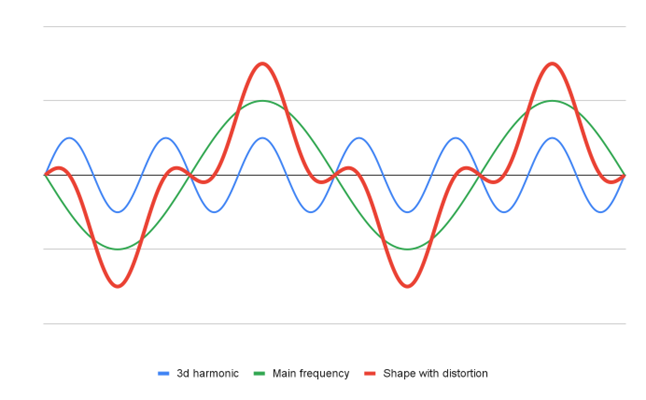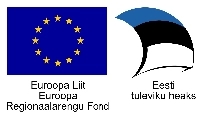Emission during the life-cycle of vehicles
The overview of the ICCT report “A global comparison of the life-cycle greenhouse gas emissions of combustion engine and electric passenger cars”

Life-cycle GHG emissions of average medium-size gasoline internal combustion engine (ICEVs) and battery electric vehicles (BEVs) registered in Europe, the United States, China, and India in 2021 and projected to be registered in 2030. The error bars indicate the difference between the development of the electricity mix according to stated policies (the higher values) and what is required to align with the Paris Agreement.
In 2021, the International Council on Clean Transportation (ICCT) conducted a study comparing the life cycle greenhouse gas (GHG) emissions of electric and internal combustion engine vehicles. The study has been provided in Europe, USA, China, India.
The report states that only battery electric vehicles (BEVs) have the potential to reduce greenhouse gas emissions over the life cycle needed to meet the goals of the Paris Agreement.
Even hydrogen-powered fuel cell electric vehicles (FCEV) have lower rates. This is because the main source of hydrogen today is a form of methane from natural gas (so-called “grey hydrogen”), which results in more modest efficiency figures.
However, the use of hydrogen derived from renewable electricity (“green hydrogen”) would result in a 76% to 80% reduction in lifecycle greenhouse gas emissions for FCEVs.
As shown in the first figure, life cycle emissions of medium-sized electric vehicles (BEVs) are already lower today in all regions examined – by 66-69% in Europe, by 60-68% in the United States, by 37-45% in China and by 19–34% in India.
As energy systems decarbonise, the gap between EV and ICE life cycle emissions will widen and by 2030 will be 74-77% in Europe, 62-76% in the US, 48-64% in China and 30-56% in India.
The large spread is explained by the uncertainty in the development of the electric power industry in these regions.
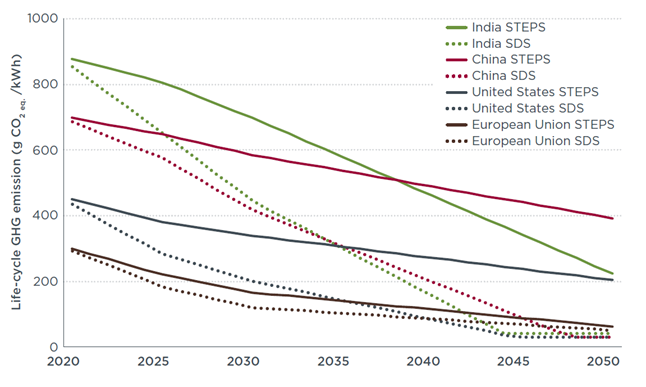
Life-cycle GHG emissions of electricity consumption based on an electricity mix of IEA’s Stated Policy (STEPS) and Sustainable Development Scenario (SDS), the IPCC’s life-cycle GHG emission factors, and energy losses in the grids.
It is also worth paying attention to the high emissions of cars running on natural gas. Contrary to popular belief about the environmental friendliness of such engines, the results of the study do not confirm this, at least in terms of greenhouse gas emissions.
The report specifically emphasizes that there is currently no reasonable way to achieve deep decarbonization for ICE vehicles. This may indicate that, within the framework of today’s trends towards the preservation of a favorable natural environment, sales of electric vehicles with internal combustion engines do not have significant prospects. Actually, this is confirmed by real practice in the considered regions of the planet.
This is clearly shown in the figures below.
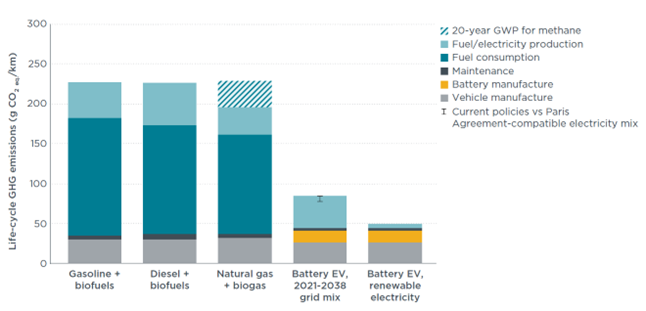
Life-cycle GHG emissions of small segment gasoline, diesel, and CNG ICEVs and BEVs registered in Europe in 2021.
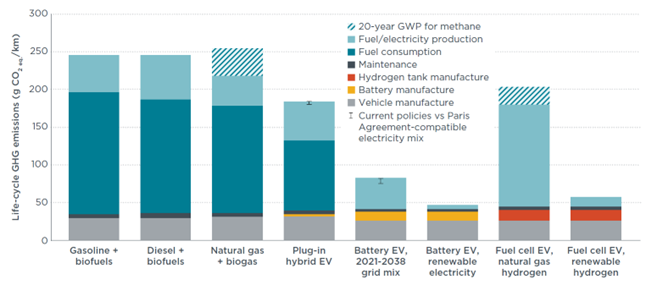
Life-cycle GHG emissions of lower medium segment gasoline, diesel, and CNG ICEVs, PHEVs, BEVs, and FCEVs registered in Europe in 2021.
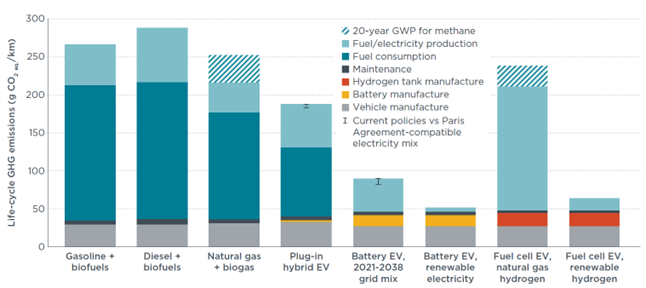
Life-cycle GHG emissions of SUV segment gasoline, diesel, and CNG ICEVs, PHEVs, BEVs, and FCEVs registered in Europe in 2021.
Hybrids (HEV) improve the efficiency of gasoline/diesel vehicles by recovering braking energy and storing it in a battery that can then be used to support driving with an electric motor. The authors of the report found that HEVs reduce life cycle greenhouse gas emissions by only about 20% compared to conventional gasoline vehicles.
Plug-in hybrids (PHEV) have a large battery that can be charged before driving, and they can operate in electric mode within a certain range. However, also in this drive mode, the electric motor is usually supported by an internal combustion engine, and thus it is not necessarily a purely electric drive.
Based on these calculations, the GHG emissions of modern midsize PHEVs compared to gasoline vehicles are 42-46% lower in the US, 25-27% lower in Europe, and 6%-12% lower in China (PHEVs are almost not registered in India).
The report also considered options for the use of synthetic (biological) liquid fuels. It is shown that it does not lead to a significant reduction in emissions, and its widespread implementation is unlikely to occur due to the high cost and limited supply.
The authors of the report say that in order to meet the goals of the Paris Agreement, the registration of new cars with internal combustion engines should be terminated in the period 2030-2035. Then, taking into account the life of cars, a deep decarbonization of the transport sector can be achieved by 2050.
At the same time, it is stated that the total amount of energy consumed by different types of vehicles is also different. A battery electric vehicle, a fuel cell vehicle and a plug-in hybrid are considered. The energy efficiency of BEV is significantly higher, as the results of the study show.
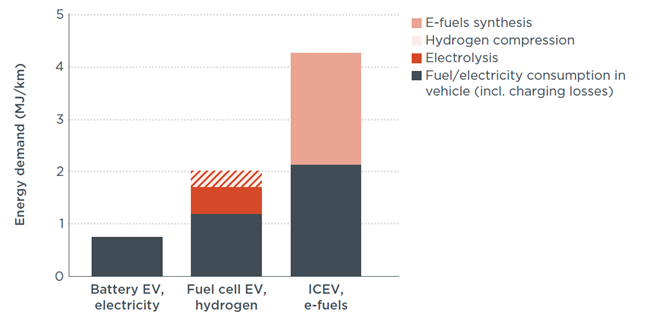
Energy demand of medium-size BEVs, FCEVs powered by electricity-based hydrogen, and ICEVs powered by e-fuels.
Taking into consideration global trends, we at ElectroAir have made a strategic decision to develop clean transport, thereby contributing to the preservation of our planet.
All illustrations are taken from the original text.
